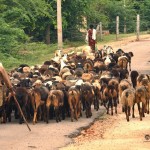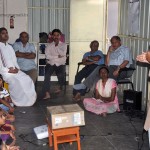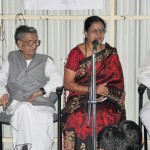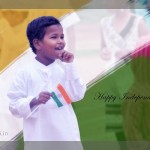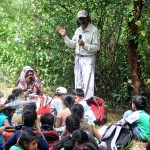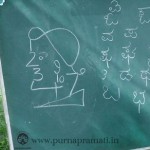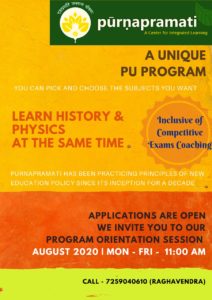
Inter School Kho-Kho Competition
Friday, November 8th, 2013ನಮà³à²® ಶಾಲೆಯ ಕà³à²°à³€à²¡à³‹à²¤à³à²¸à²µ ದಿನಾಂಕ: 28.10.2013 ಸà³à²¥à²³: ಪೂರà³à²£à²ªà³à²°à²®à²¤à²¿ ಮೈದಾನ, ಗಿರಿನಗರ, ಬೆಂಗಳೂರೠಆಟದ ಬಯಲಿಗೆ ಓಡಿ, ಆಟದ ಬಯಲಿಗೆ ಓಡಿ ಆಟದ ಬಯಲಿಕೆ ಓಡಿ, ಓಡಿ, ಓಡಿ, ಓಡಿ ಆಟದ ಬಯಲಿಕೆ ಓಡಿ, ಓಡಿ, ಓಡಿ, ಓಡಿ ಚಿನà³à²¨à²¿-ದಾಂಡೠಖೋ ಖೋ ಆಡಿ ದೇಹವ ಮೋಡಿಯ ಮಾಡಿ ಆಟವೆಂದರೆ ಮಕà³à²•à²³à²¿à²—ೆ ಎಲà³à²²à²¿à²²à³à²²à²¦ ಉತà³à²¸à²¾à²¹. ಹಸಿವà³, ನೋವà³, ಗಾಯ ಎಲà³à²²à²µà²¨à³à²¨à³‚ ಮರೆತೠಮನಃಪೂರà³à²µà²•à²µà²¾à²—ಿ ಆಡà³à²¤à³à²¤à²¾à²°à³†. ಆಟವೆಂದರೆ ತಲೆಗೆ ತೋಚಿದಂತೆ ಆಡà³à²µà³à²¦à²²à³à²². ಅದಕà³à²•à³† ಅದರದೇ ಆದ ನಿಯಮಗಳಿವೆ, ವಿಧಾನಗಳಿವೆ. ಹಲವೠಕà³à²°à³€à²¡à³†à²—ಳೠಬೇರೆ ಬೇರೆ ದೇಶಗಳ ಮೂಲವನà³à²¨à³ ಹೊಂದಿವೆ. à²à²¾à²°à²¤à³€à²¯ ಆಟಗಳಲà³à²²à²¿ ಮೆದà³à²³à²¿à²—ೆ ಮತà³à²¤à³ ದೇಹಕà³à²•à³† ಎರಡಕà³à²•à³‚ ಹೆಚà³à²šà²¿à²¨ ಕೆಲಸವಿರà³à²¤à³à²¤à²¦à³†. ಉದಾಹರಣೆಗೆ ಚದà³à²°à²‚ಗದಾಟ, ಖೋ ಖೋ, ಹಾಕಿ ಇತà³à²¯à²¾à²¦à²¿. ಆಟದಲà³à²²à²¿ ಕಲಿತ ಶà³à²°à²¦à³à²§à³†, à²à²•à²¾à²—à³à²°à²¤à³†, ಸà³à²¨à³‡à²¹à²ªà²°à²¤à³†à²—ಳನà³à²¨à³ ಓದಿನಲà³à²²à²¿ ಮತà³à²¤à³ ಜೀವನದಲà³à²²à²¿ ಅಳವಡಿಸಿಕೊಳà³à²³à³à²µà³à²¦à³ ಕà³à²°à³€à²¡à³†à²—ಳ ಅಂತಿಮ ಫಲ. ಸೋಲà³-ಗೆಲವà³à²—ಳೠಇದಕà³à²•à³† ಪೂರಕವಾಗಿರà³à²¤à³à²¤à²µà³†. à²à²¾à²°à²¤à³€à²¯ ಆಟಗಳನà³à²¨à³ ಉತà³à²¤à³‡à²œà²¿à²¸à³à²µ ಉದà³à²¦à³‡à²¶à²¦à²¿à²‚ದ ಪೂರà³à²£à²ªà³à²°à²®à²¤à²¿à²¯à³ ದಿನಾಂಕ 28.10.2013ರಂದೠಅಂತರà³-ಶಾಲಾ ಖೋ ಖೋ ಪಂದà³à²¯à²¾à²µà²³à²¿à²¯à²¨à³à²¨à³ à²à²°à³à²ªà²¡à²¿à²¸à²¿à²¤à³à²¤à³. ಪಂದà³à²¯à²µà³ ನಡೆದದà³à²¦à³ 28ನೇ ದಿನಾಂಕದಂದà³. ಆದರೆ ಅದಕà³à²•à³† ತಯಾರಿ ಒಂದೠತಿಂಗಳ ಮೊದಲೆ ಪà³à²°à²¾à²°à²‚à²à²µà²¾à²—ಿತà³à²¤à³. ಇತರ ಶಾಲೆಗಳನà³à²¨à³ ಆಹà³à²µà²¾à²¨à²¿à²¸à³à²µà³à²¦à²°à²¿à²‚ದ ಆರಂà²à²¿à²¸à²¿, ಮಕà³à²•à²³ ತಯಾರಿ, ವà³à²¯à²µà²¸à³à²¥à³†à²—ಳ ಬಗà³à²—ೆ ಇಡೀ ಶಾಲೆಯೇ ಕೈಜೋಡಿಸಿ ಸಹಕರಿಸಿತà³. ನಮà³à²® ಕà³à²°à³€à²¡à²¾ ಅಧà³à²¯à²¾à²ªà²•à²°à²¾à²¦ ಶಶಿಅಣà³à²£ ಅವರಂತೂ ಮಕà³à²•à²³à²¨à³à²¨à³ ಯಾವ ಹಂತದಲà³à²²à³‚ ಎಚà³à²šà²° ತಪà³à²ªà²¦à²‚ತೆ ಖೋ ಖೋ ಪಂದà³à²¯à²•à³à²•à³† ಅಣಿಗೊಳಿಸಿದà³à²¦à²°à³. ಪà³à²°à²¤à²¿à²¨à²¿à²¤à³à²¯ 2-3 ತಾಸೠಅà²à³à²¯à²¾à²¸ ನಡೆದೇ ಇತà³à²¤à³. ಪೋಷಕರೂ ಸಹ ಮಕà³à²•à²³à²¨à³à²¨à³ ನಿತà³à²¯ ಅà²à³à²¯à²¾à²¸à²•à³à²•à³† ಕರೆದೠತರà³à²¤à³à²¤à²¿à²¦à³à²¦à²°à³. ಆಟದ ದಿನ ಹತà³à²¤à²¿à²°à²µà²¾à²—à³à²¤à³à²¤à²¿à²¦à³à²¦à²‚ತೆ ಎಲà³à²²à²° ಮನದಲà³à²²à³‚ ಒಂದೠಉತà³à²¸à²¾à²¹, ಮಕà³à²•à²³à³ ಹೇಗೆ ಆಡà³à²µà²°à³‹ ಎಂಬ ಕà³à²¤à³‚ಹಲ ಕಾಯà³à²¤à³à²¤à²¿à²¤à³à²¤à³. ಈ ಪಂದà³à²¯à²¦à²²à³à²²à²¿ ಪೂರà³à²£à²ªà³à²°à²®à²¤à²¿à²¯à³‚ ಸೇರಿದಂತೆ ಗಿರಿನಗರದ ಸà³à²¤à³à²¤à²®à³à²¤à³à²¤à²² 8 ಶಾಲೆಗಳೠà²à²¾à²—ವಹಿಸಿದà³à²¦à²µà³. ಸಿಸà³à²Ÿà²°à³ ನಿವೇದಿತಾ ಶಾಲೆ, ರತà³à²¨à²—ಿರಿ ವಿದà³à²¯à²¾à²¸à²‚ಸà³à²¥à³†, ಸಿ.ಬಿ.ಎಲà³. ಮದರೠತೆರೇಸಾ ಶಾಲೆ, ಮೌಂಟೠಎವೆರೆಸà³à²Ÿà³ ಶಾಲೆ, ಕನಕ ವಿದà³à²¯à²¾à²¸à²‚ಸà³à²¥à³†, ಶಾರದಶà³à²°à³€ ವಿದà³à²¯à²¾à²¸à²‚ಸà³à²¥à³†, ಶಾಂತಿ ನಿಕೇತನ ಇಂಗà³à²²à²¿à²·à³ ಶಾಲೆಗಳ ಪರವಾಗಿ ಬಾಲಕರೠಮತà³à²¤à³ ಬಾಲಕಿಯರ ಪà³à²°à²¤à³à²¯à³‡à²• ತಂಡಗಳೠಆಗಮಿಸಿದà³à²¦à²µà³. ಪà³à²°à²¾à²¥à²®à²¿à²•à²¶à²¾à²²à²¾ ಮಕà³à²•à²³ ವಿà²à²¾à²—ದ ಈ ಪಂದà³à²¯à²µà³ ನಿರೀಕà³à²·à³†à²—ೂ ಮೀರಿ ಮಕà³à²•à²³ ನಿಜವಾದ ಸಾಮರà³à²¥à³à²¯à²µà²¨à³à²¨à³ ಎಲà³à²²à²°à²¿à²—ೂ ತೋರಿಸಿತà³à²¤à³. ಅಂತೂ ಪಂದà³à²¯à²¾à²µà²³à²¿à²¯ ದಿನ ಬಂದೆ ಬಿಟà³à²Ÿà²¿à²¤à³…. ಮೈದಾನ ಸà³à²µà²šà³à²›à²µà²¾à²—ಿ ಸಿದà³à²§à²µà²¾à²¯à²¿à²¤à³, ವಿವಿಧ ತಂಡಗಳೠಕà³à²³à²¿à²¤à³à²•à³Šà²³à³à²³à²²à³ ಶಾಮಿಯಾನ, ಕà³à²¡à²¿à²¯à³à²µ ನೀರಿನ ವà³à²¯à²µà²¸à³à²¥à³†, ಪà³à²°à²¥à²® ಚಿಕಿತà³à²¸à³†, ಊಟದ ವà³à²¯à²µà²¸à³à²¥à³†, ಹೀಗೆ ಎಲà³à²²à²µà³‚ ತಯಾರಾಯಿತà³. ಗಿರಿನಗರದ ಹನà³à²®à²‚ತಪà³à²ªà²¨à²µà²°à³ ತಮà³à²® ನಿವೇಶನವನà³à²¨à³ ಅà²à²¿à²®à²¾à²¨à²ªà³‚ರà³à²µà²•à²µà²¾à²—ಿ ಪೂರà³à²£à²ªà³à²°à²®à²¤à²¿à²¯ ಕಾರà³à²¯à²—ಳಿಗೆ ಬಿಟà³à²Ÿà³à²•à³Šà²Ÿà³à²Ÿà²¦à³à²¦à³ ನಿಜಕà³à²•à³‚ ಶà³à²²à²¾à²˜à²¨à³€à²¯. ಬೆಳಗà³à²—ೆ 8.40 ರಿಂದ ವಿವಿಧ ಶಾಲೆಯವರೠಬರಲೠಆರಂà²à²¿à²¸à²¿à²¦à³à²¦à²°à³. ಅತಿಥಿಗಳಿಗೆ ತಿಲಕ ಹಚà³à²šà²¿ ಹೂವನà³à²¨à³ ಕೊಟà³à²Ÿà³ ಸà³à²µà²¾à²—ತಿಸಿದೆವà³. ಅಂದಿನ ಮà³à²–à³à²¯ ಅತಿಥಿಗಳಾಗಿ ಉಮೇಶà³.ಆರೠ(ಕà³à²°à³€à²¡à²¾ ನಿರà³à²¦à³‡à²¶à²•à²°à³, ಸರಕಾರಿ ಪà³à²°à²¥à²® ದರà³à²œà³† ಕಾಲೇಜà³, ತà³à²¯à²¾à²®à²—ೊಂಡಲà³) ಮತà³à²¤à³ ರಾಷà³à²Ÿà³à²°à³€à²¯ ಮಟà³à²Ÿà²¦ ಖೋ ಖೋ ಆಟಗಾರà³à²¤à²¿ ಶà³à²°à³€à²®à²¤à²¿ ಅನಿತಾ ಅವರೠಆಗಮಿಸಿದರà³. ಅತಿಥಿಗಳಿಗೆ ಸà³à²µà²¾à²—ತ, ಪà³à²°à²¾à²°à³à²¥à²¨à³†, ಪà³à²°à²¤à²¿à²œà³à²žà²¾à²¸à³à²µà³€à²•à²¾à²°, à²à³‚ಮಿ ಪೂಜೆ, ಧà³à²µà²œà²¾à²°à³‹à²¹à²£, à²à²¾à²°à²¤ ಮಾತೆಗೆ ಪà³à²·à³à²ªà²¾à²°à³à²šà²¨à³† ಎಲà³à²²à²¾ ಕಾರà³à²¯à²—ಳನà³à²¨à³ ವಿದà³à²¯à²¾à²°à³à²¥à²¿à²—ಳೠಅಚà³à²šà³à²•à²Ÿà³à²Ÿà²¾à²—ಿ ನಡೆಸಿಕೊಟà³à²Ÿà²°à³. ನಮà³à²® ಶಾಲೆಯ ಹಾಡಿನ ಶಿಕà³à²·à²•à²°à²¾à²¦ ರಾಜೇಂದà³à²°à²£à³à²£ ಈ ದಿನಕà³à²•à²¾à²—ಿ ವಿಶೇಷ ಹಾಡನà³à²¨à³ ರಚಿಸಿ, ರಾಗ ಸಂಯೋಜಿಸಿ ಮಕà³à²•à²³à²¿à²—ೆ ಅà²à³à²¯à²¾à²¸ ಮಾಡಿಸಿದà³à²¦à²°à³. ಮಕà³à²•à²³à³ ಬೆಳಗಿನ ಉತà³à²¸à²¾à²¹à²µà²¨à³à²¨à³ ಮತà³à²¤à²·à³à²Ÿà³ ಹೆಚà³à²šà²¿à²¸à³à²µà²‚ತೆ ಈ ಹಾಡನà³à²¨à³ ಹಾಡಿದರà³: ಖೋ ಖೋ ಆಟವ ಆಡೋಣ ಎಲà³à²²à²° ಜೊತೆಗೂ ಬೆರೆಯೋಣ ಸಾಂಘಿಕ ಶಕà³à²¤à²¿à²¯ ಬೆಳೆಸೋಣ ದೇಹಾರೋಗà³à²¯à²µ ಪಡೆಯೋಣ ಆಟದಿ ಶಕà³à²¤à²¿à²¯à³ ಆಟದಿ ಯà³à²•à³à²¤à²¿à²¯à³ ಆಟವೆ ಮನಗಳ ಸೇತà³à²µà³†à²¯à³ ಆಟವ ಆಡà³à²¤ ಮà³à²¦à²µà²¨à³ ಪಡೆಯà³à²¤ à²à²¾à²µà³ˆà²•à³à²¯à²¤à³†à²¯à²¨à³ ಬೆಳೆಸೋಣ ಬನà³à²¨à²¿à²°à²¿ ಆಟವ ಆಡೋಣ ಎಲà³à²²à²° ಜೊತೆಗೂ ಬೆರೆಯೋಣ ಕà³à²°à³€à²¡à³†à²¯à²¨à²¾à²¡à³à²¤ à²à²¾à²°à²¤ ಮಾತೆಗೆ ದಿನವೂ ಸೇವೆಯ ಮಾಡೋಣ ಅತಿಥಿಗಳೠಮಾತಿಗಿಂತ ಕà³à²°à²¿à²¯à³†à²¯à³‡ ಉತà³à²¤à²®, ಸೋಲà³-ಗೆಲà³à²µà³à²—ಳಿಗಿಂತ ಮà³à²–à³à²¯à²µà²¾à²—ಿ ಕà³à²°à³€à²¡à²¾ ಮನೋà²à²¾à²µ ಮತà³à²¤à³ ಬಾಂಧವà³à²¯à²µà³‡ ಆಟದಲà³à²²à²¿ ಮà³à²–à³à²¯ ಎಂದೠತಿಳಿಸಿ ತಾವೠಆಡà³à²µà³à²¦à²°à³Šà²‚ದಿಗೆ ಪಂದà³à²¯à²•à³à²•à³† ಚಾಲನೆ ಕೊಟà³à²Ÿà²°à³. ಮಕà³à²•à²³ ಉತà³à²¸à²¾à²¹à²µà²¨à³à²¨à³ ಮತà³à²¤à²·à³à²Ÿà³ ಉತà³à²¤à³‡à²œà²¿à²¸à³à²µà²‚ತೆ ಅà²à²¿à²¨à²‚ದಿಸಿ ಆಟ ನೋಡಲೠತಾವೂ ಕà³à²³à²¿à²¤à²°à³. ಯಾವ ತಂಡಗಳೠಯಾವ ತಂಡಗಳೊಂದಿಗೆ ಆಡಬೇಕೆಂಬ ಯೋಜನೆಯಂತೆ ಒಂದೊಂದೇ ತಂಡಗಳೠಆಡತೊಡಗಿದವà³. ಕೆಲವೠತಂಡಗಳೠಮೊದಲೆ ಚೆನà³à²¨à²¾à²—ಿ ಅà²à³à²¯à²¾à²¸ ಮಾಡಿ ಬಂದಿದà³à²¦à²µà³. ಒಂದೊಂದೇ ತಂಡಗಳೠಸೋಲà³à²¤à³à²¤à²¾ ಹೋದಂತೆ ಅಂತಿಮ ಸà³à²¤à³à²¤à²¿à²—ೆ ತಂಡಗಳೠಆಯà³à²•à³†à²¯à²¾à²¦à²µà³. ಮಳೆರಾಯ ತಾನೂ ಪಂದà³à²¯ ನೋಡಲೠಬಂದನà³. ಪಂದà³à²¯ ನೋಡಲೠಬಂದ ಮಳೆರಾಯನಿಗೆ ಬೇಸರವಾಗದಿರಲೆಂದೠಮಕà³à²•à²³à³ ಮಳೆಯಲà³à²²à³‚ ಒಂದೠಪಂದà³à²¯à²µà²¨à³à²¨à²¾à²¡à²¿à²¦à²°à³. ಅಂತಿಮ ಸà³à²¤à³à²¤à²¿à²—ೆ ರತà³à²¨à²—ಿರಿ ವಿದà³à²¯à²¾à²¸à²‚ಸà³à²¥à³† ಮತà³à²¤à³ ಪೂರà³à²£à²ªà³à²°à²®à²¤à²¿à²¯ ಮಕà³à²•à²³ ತಂಡಗಳೠಆಯà³à²•à³†à²¯à²¾à²¦à²µà³. ಅಲà³à²²à²¿à²¯ ಒಂದೊಂದೠನೋಟ, ಓಟ, ಜೂಟಾಟ ಕà³à²·à²£à²•à³à²·à²£à²•à³à²•à³‚ ಉತà³à²¸à²¾à²¹à²µà²¨à³à²¨à³ ಹೆಚà³à²šà²¿à²¸à³à²¤à³à²¤à²²à³‡ ಇತà³à²¤à³. ತಮà³à²®à³†à²²à³à²² ಜಾಣà³à²®à³†, à²à²•à²¾à²—à³à²°à²¤à³†, ಸತತ ಅà²à³à²¯à²¾à²¸, ನಿಯಮಗಳ ಅರಿವà³à²—ಳನà³à²¨à³ ಒಟà³à²Ÿà³à²—ೂಡಿಸಿ ಎಚà³à²šà²°à²¿à²•à³†à²¯à²¿à²‚ದ ಆಡಿದ ಪೂರà³à²£à²ªà³à²°à²®à²¤à²¿à²¯ ಬಾಲಕರೠಮತà³à²¤à³ ಬಾಲಕಿಯರೠಜಯಶಾಲಿಗಳಾದರà³. ಪà³à²°à²¾à²‚ಶà³à²ªà²¾à²²à²°à³ ಅನಾರೋಗà³à²¯à²¦à²¿à²‚ದ ವಿಶà³à²°à²¾à²‚ತಿ ಪಡೆಯಬೇಕಾಗಿದà³à²¦à²°à³‚ ಈ ಉತà³à²¸à²µà²µà²¨à³à²¨à³ ಕಣà³à²£à²¾à²°à³† ಕಾಣà³à²µ ತವಕದಿಂದ ಮೈದಾನಕà³à²•à³† ಧಾವಿಸಿ ಬಂದರà³. ಈ ಯಜà³à²žà²¦à²²à³à²²à²¿ ಯಾರ ಪರಿಶà³à²°à²®à²µà³‚ ವà³à²¯à²°à³à²¥à²µà²¾à²—ಲಿಲà³à²². ಅಂತೂ ಅಂತಿಮ ಜಯ ನಮà³à²®à²¦à²¾à²¯à²¿à²¤à³. ಮಕà³à²•à²³ ಮà³à²‚ದಿನ ಸಾಧನೆಗೆ ದಾರಿದೀಪವಾಯಿತà³. ಪಂದà³à²¯à²¦à²²à³à²²à²¿ à²à²¾à²—ವಹಿಸಿದ ಎಲà³à²²à²°à²¿à²—ೂ ಬಹà³à²®à²¾à²¨ ಪತà³à²°à²µà²¨à³à²¨à³ ನೀಡಲಾಯಿತà³. ಈ ಬಹà³à²®à²¾à²¨ ಪತà³à²°à²¦ ವಿಶೇಷವೆಂದರೆ ಅದನà³à²¨à³ ಮಕà³à²•à²³à³‡ ತಮà³à²® ಕೈ ಬರಹದಿಂದ, ಚಿತà³à²°à²—ಳಿಂದ ತಯಾರಿಸಿದà³à²¦à²°à³. ಸಂಜೆಯ ಬಹà³à²®à²¾à²¨ ವಿತರಣಾ ಕಾರà³à²¯à²•à³à²°à²®à²•à³à²•à³† ರಾಜà³à²¯à²®à²Ÿà³à²Ÿà²¦ ಖೋ ಖೋ ಕà³à²°à³€à²¡à²¾à²ªà²Ÿà³à²—ಳಾದ ಶà³à²°à³€à²¯à³à²¤ ರಾಮà³, ಗಣಿತಜà³à²žà²°à²¾à²¦ ಶà³à²°à³€à²®à²¤à²¿ ಆನಂದ ಲಕà³à²·à³à²®à³€, ರಬà³à²¬à²°à³ ಉದà³à²¯à²®à²¿à²¯à²¾à²¦ ಮಣೂರೠನರಸಿಂಹ ಪೈ ಮà³à²‚ತಾದವರೠಆಗಮಿಸಿದà³à²¦à²°à³. ಇವರೆಲà³à²²à²°à³‚ ಸಮಾಜದಲà³à²²à²¿ ಮಕà³à²•à²³ ವಿದà³à²¯à²¾à²à³à²¯à²¾à²¸à²•à³à²•à³† ಧನಸಹಾಯದೊಂದಿಗೆ, ಶಾಲೆಗಳನà³à²¨à³ ನಿರà³à²®à²¿à²¸à²¿ ಕà³à²°à³€à²¡à³†à²—ಳನà³à²¨à³ ಪà³à²°à³‹à²¤à³à²¸à²¾à²¹à²¿à²¸à³à²µà²µà²°à²¾à²—ಿದà³à²¦à²¾à²°à³†. ಇವರ ಆಶೀರà³à²µà²¾à²¦à²µà²¨à³à²¨à³, ಬಹà³à²®à²¾à²¨à²µà²¨à³à²¨à³‚ ಪಡೆದ ಮಕà³à²•à²³à³ ತಮà³à²® ಕೊರಳಲà³à²²à²¿ ಕಂಗೊಳಿಸà³à²¤à³à²¤à²¿à²°à³à²µ ಪದಕಗಳೠಮತà³à²¤à³ ಬಹà³à²®à²¾à²¨à²µà²¨à³à²¨à³ ನೋಡà³à²¤à³à²¤à²¾ ಸಾವಿರ ಕನಸà³à²—ಳನà³à²¨à³ ನಾಳೆಗಾಗಿ ಕಟà³à²Ÿà²²à³ ಆರಂà²à²¿à²¸à²¿à²¦à²°à³. ಪೂರà³à²£à²ªà³à²°à²®à²¤à²¿à²¯ ಈ ಮರಿಸೈನà³à²¯à²µà³ ಮà³à²‚ದಿನ ಮೂರೠವರà³à²·à²—ಳಲà³à²²à²¿ ರಾಜà³à²¯à²®à²Ÿà³à²Ÿà²¦ ಖೋ ಖೋ ತಂಡವಾಗಿ ಹೊರಹೊಮà³à²®à³à²µ à²à²µà²°à²¸à³†à²¯à²¨à³à²¨à³ ಹೊತà³à²¤à³ ನಾವೆಲà³à²² ಮನೆಗೆ ತೆರಳಿದೆವà³. Inter School Kho-Kho Competition “28th October 2013” Purnapramati organized the Inter school Kho-Kho competition on 28th October’2013 with a zeal to promote the game which has its origin from our country. It was a thrilling experience to see 15 teams participating from different schools. The day started with an Inauguration program. Wherein, all the players assembled in the ground with a hope to win and to prove their metal. All the players their respective coaches and P.T masters were given a warm traditional welcome by putting tilak on their forehead and by giving flowers. Then the chief guest Mrs. Anitha Reddy (national level Kho-Kho player), Mr. Umesh (director of sports, govt. college Yelahanka) and Hanumanthappa were welcomed by a grand salute by the purnapramatians. It followed with a flag hoisting and introduction of teams and officials to the guest. A welcome speech was given by Indumati akka (teacher purnapramati) and an invocation song on Kho-Kho game was sung by purnapramati children which was composed by our music teacher (Rajender anna). Anitha Reddy, Umesh and the captains of the teams played the Kho-kho game which marked the inauguration of the meet. Then it followed with the oath taking by all the players of all the schools. The chief guest also addressed the audience and players by sharing few tips on the game. Shashi anna the sports teacher of purnapramati announced the match time table and tournament instructions which followed with the vote of thanks. In the closing ceremony the players assembled for the final play and the chief guest Mr.& Mrs. Ramu (national level Kho-Kho player), Mr. Prabhakaran (national level Kho- Kho player) and Mr. Sunder Raj shetty (participant in International sprint event 100 meters) were given a warm welcome by all. Then the game took its more thrilling and breath taking moment when purnapramati boys and girls team came in finals against Ratnagiri school. It was a moment to cherish and live with to see the zeal of both the teams to win. The match took many turning points but at last the trophy of the event was won by the Purnapramati team. We won the boys and girls finals and both the trophies came into the kitty of purnapramati after seeing this there was no boundry for happiness of parents, teachers, players and the students of purnapramati and all ran into the ground to hug and congratulate the winning stars of purnapramati. It was an overwhelming experience to see the prize distribution for winning and runner up teams. The day ended with vote of thanks and flag down ceremony. The day was over but the joy








